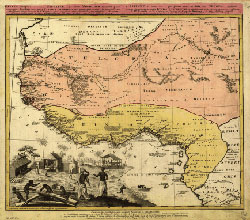Trekking to Timbuktu: Restoring the Past — Student Version
Here is the last major topic you need to cover for the big pitch
you're going to make to the producers of Globe Trekkers—and it's very important
one. Who wants to travel to see a bunch of sand-covered ruins? Lots of things
are being done to rescue the buildings and the ancient manuscripts of the long
gone days of past glory. Once you find out what these are, you can present them
as a major reason for Globe Trekkers to visit the "reawakening" city of Timbuktu!
As you begin this task, you should be thinking about answering the following
questions:
What environmental factors threaten Timbuktu?
What measures are being taken to restore the mosques?
What is the condition of the ancient manuscripts, and what is being done
to preserve them?
Once you're done your research, you'll be able to:
- Describe the environmental conditions that presently threaten Timbuktu
- Explain what efforts are being made to restore the ancient mosques
- Describe the condition of the ancient manuscripts and tell what is being done to preserve them
Before you begin, check out the background information about rescuing
the city by visiting the following websites:
Suggested Activities:
1. Life in Modern Timbuktu
2. Environmental Hazards
3. Restoring the Mosques
4. Rescuing the Manuscripts
1. Life in Modern Timbuktu
You've arrived in modern Timbuktu.
Since 1960, it has been a part of the Republic of Mali. It doesn't look at
all like a bustling modern city—Paris or New York this is not! And yet, Timbuktu has a thriving economy. As in ancient times,
it is an important center of the salt trade, and the long tradition of Islamic
scholarship has not yet died.
Photo op!
Take out your notepad! You're about to learn a lot about Timbuktu
in the 21st century.
- Access The
Timbuktu Salt Trade. Taoudenni is a site of salt mines in Mali. In early
times, larger and more significant salt mines were located in Targhaza, Morocco.
Photo op!
- Go to Salt
of the Earth. Why do you think there is such a huge demand for salt in
Mali? Now go to Salt-hauling
camel trains. What modern invention is currently threatening the traditional
salt trade?
- Read about scholarship in Timbuktu at University
of Timbuktu. Scroll down to The Circle of Knowledge: A Contemporary
Voice for Traditional Scholars. What roles do the scholars play in modern
Timbuktu?
2. Environmental Hazards
Ancient Timbuktu stood on the edge of the Sahara Desert. Today, the desert
sands are constantly creeping further and further south, threatening all that
stands in their way.
Photo op!
- Access Deserts and the
Sahel. Scroll down to the third paragraph. Why is the sahel shrinking?
- Go to Sahel.
What crises have been experienced in the sahel in recent years? What strategies
are suggested to stop the spread of the deserts?
Photo op!
Photo op!
3. Restoring the Mosques
In response to the threat of encroachment by desert sands, Timbuktu was inscribed
on the World Heritage List in Danger in 1990 and UNESCO established a conservation
program to safeguard it.
Photo op!
- Scroll down to A Town imperiled by sand… ). In what ways has the general
population become involved in preserving the buildings? What work needs to
be done on the mosques? How successful have restoration efforts been?
- Now go to Djenne,
Mali. Scroll to the final three paragraphs. How does local culture help
in the process of preserving ancient buildings in Mali?
4. Rescuing the Manuscripts
The manuscripts dating back to the 13th century have survived in Timbuktu because
of dry heat. But these, too, are in danger of being destroyed.
Photo op!
- Go to Condition
of the Manuscripts. What factors, apart from natural ones, endanger the
manuscripts?
- Go to The Road to Timbuktu.
Click on Gates Diary. Then, under Related Diary Entries,
click on Ancient Manuscripts.
- Now go to Significance
of the Manuscripts. In what ways can the ancient manuscripts alter the
views Europeans have long held about West Africa? How can recovery and preservation
of the manuscripts help to improve the economy of northern Mali? How can tourism
help in the efforts to preserve Timbuktu's scholarly past? Take note:
make sure your tell the folks at Globe Trekker about this!
Photo op!
Location Scouting Summary: Indiana Jones Finds Treasures of Timbuktu
Review the notes and pictures you've taken in this project. Then
write an article entitled “The Ancient Manuscripts of Timbuktu.”
Selected EDSITEment Websites
African Studies WWW
[http://www.sas.upenn.edu/African_Studies/AS.html]
Internet Public Library
[http://www.ipl.org]
National Geographic Xpeditions
Standards Alignment
View your state’s standards
|





